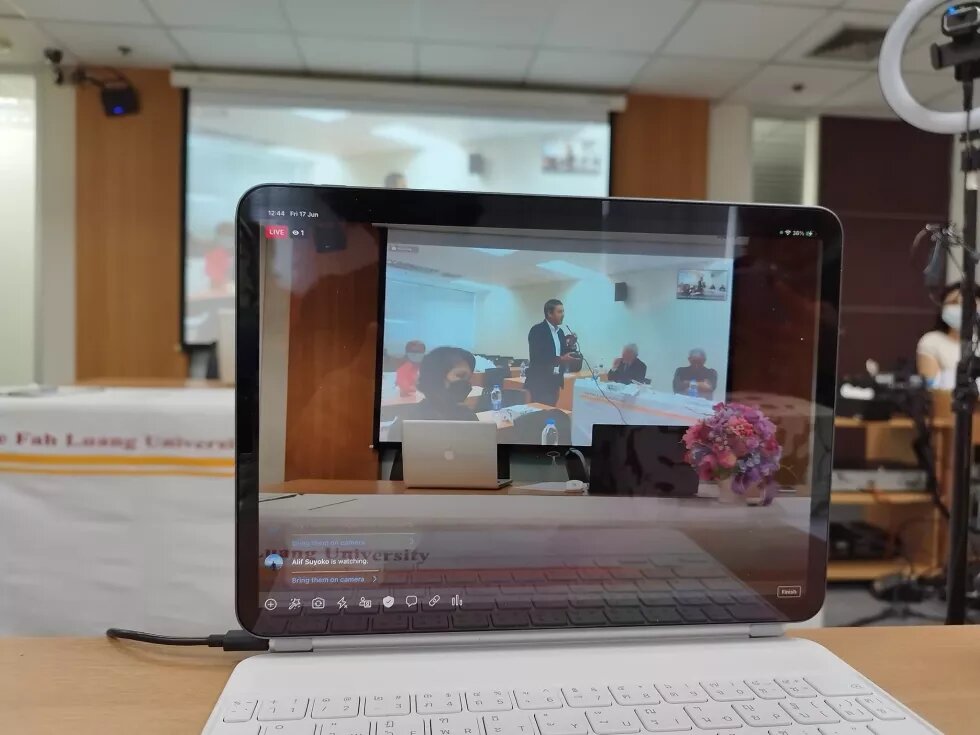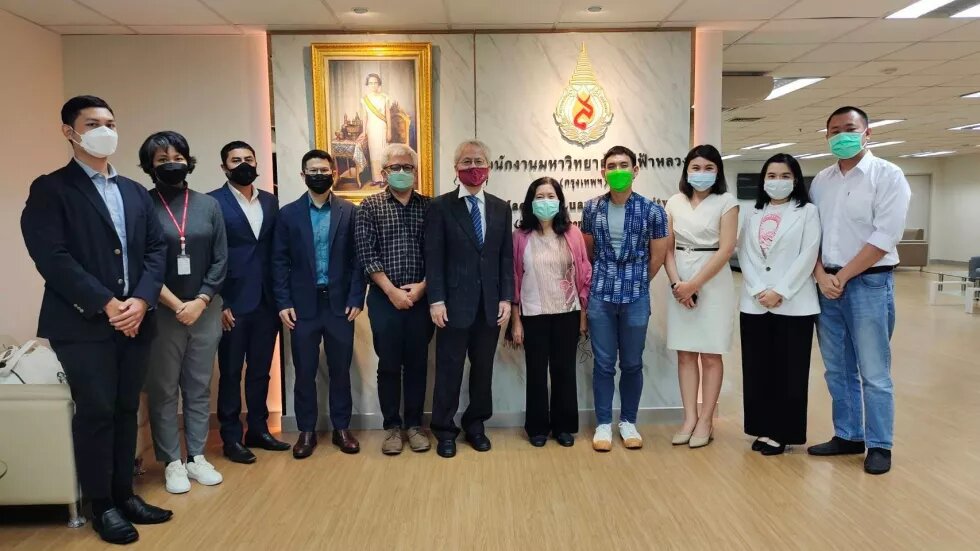
A Conference note from “Paradigm Shift in International Development towards SDGs and the 2030 New Global Agenda” on Friday, 17 June 2022 co-organized by Mae Fah Luang University and Heinrich-Böll-Stiftung Southeast Asia regional office

The term “sustainability” gains more visibility in International Development as it becomes the fulcrum of the global agenda for action toward 2030 future horizons. Nevertheless, sustainability is not a fixed term to limit itself to an epistemic standpoint or certain perspective. Instead, sustainability is situated; it refers to how it is attached to a particular context and actively shaped by practices across multidimensional aspects of life is seen from an interdisciplinary point of view. The panel articulates how discourses of sustainability are produced and reproduced into the domains of the 5Ps: People, Planet, Prosperity, Partnership, and Peace. It further appreciates the challenge of situating sustainability by engaging contributions of academic experts to consider the production of sustainability knowledge and commentaries on a particular vision of development are contested as it rationalizes public policy, planning, and even way down to ethical conditions in material practices like people-capital mobility, environmental crisis, economic gap and inequality, violence, and fractional alignment in political spectra. The panel illuminates what has been and has not been pointed out in the United Nations’ 2030 global pledge agenda of Sustainable Development Goals (SDGs).
Competing Development Agendas Inflicting Mobility of People for the Flow of Capital
Assoc. Prof. Dr. Naruemon Thabchumpon from Chulalongkorn University opens the panel with a robust sense that SDGs linger within the layers of competing for regional development agendas. In the Southeast Asia context, the inauguration of SDGs came with the ongoing agenda of the ASEAN Economic Community 2015 and the Greater Mekong Subregion Economic Corridor measuring regional economic performance. However, the agendas of reducing poverty for “a better future” concentrate solely on regional prosperity on economic growth showing countries ways to reduce poverty and grow according to gross domestic product. This standpoint puts a paradox on SDG 8 (Decent Work and Economic Growth) that carries social disparity and economic exploitation, imposing widened inequality gap among the people. For example, two million people work as migrants in Thailand from Myanmar, Cambodia, and Lao PDR in 3D working conditions (Dirty, Dangerous, Difficult). Rapid urbanization growth has led to urban flood risk. Under the COVID-19 situation, female migrant workers were hit the hardest with low wages, less access to healthcare, and the risk of being unemployed. Shifting the talk to the “People,” we start to ask a question: have we achieved sustainability for the people? Detailing the SDGs narratives for the people highlights the economic and political stakes between the mobility flow of capital/products and the mobility of the people. There are frameworks applied to tackle poverty and reduce inequality. As such legislative framework, institutional structure, national policy, and integration with national development strategies. However, economic growth remains at the cost of greater inequality, higher unemployment, weakened democracy, loss of cultural identity, or overconsumption of natural resources needed by future generations.
The Crisis of Global Environmental Governance from Disconnected Development Agendas
Dr. Chaya Vaddhanaphuti from Chiang Mai University poses a fundamental challenge to every aspect of the mainstream environmental discourse. How we govern the environment shapes how we design our policy, and vice versa; the policy used for regulating our environment also shapes how we govern the world. In this conception, the “environment” is produced and reproduced from dominant rationality to guide principles in designing policies through shifting paradigms. About 100 years ago, the environment was perceived as a “service” to people. It implicated the conservation and preservation outcomes through rules of management and use in territorial zoning established in the act of governing nature. Then, the industrial era brought the environment as “fragile” and “finite.” There were limits to growth in nature as opposed to the increasing human population. Subsequently, society needed to be controlled from growing too fast and consuming too many natural resources. However, the human population and consumption of earth resources continued on a bigger scale and rates, inducing the framing of the environment as “indices” for sustainability from the ecological footprints of pollution within the earth’s boundaries. Through geoengineering, human-invented projects and experiments alter (fix) the ecosystems. While in fact, environments are “chaotic” and “uncontrollable.” Following the increasing intensity and frequency of natural disasters and climate change, the community is directed toward adaptation and resilience of social-ecological systems, soon to be integrated with the idea of weak and strong sustainability in which the environment plays a crucial role in economic development. Shifting the talk to the “Planet,” we ask: Could SDGs help us rethink environmental governance? Perhaps, SDGs should be seen interdependently as the environmental crisis is also interconnected with one another. For example, to tackle haze pollution, SDG 3 (Good Health and Well-Being) should be interconnected to SDG 13 (Climate Action) and SDG 15 (Life on Land) while also working on a series of indirect policies and supports for other SDG indicators to provide social equality and accumulate multipurpose benefits.
The Biggest Issue in Development Agendas is Multifaceted Inequality
Dr. Nuttavikhom Phanthuwongpakdee from Thammasat University observes the obsession with economic growth in a finite world that does not suit infinite growth. Shifting the talk to “Prosperity,” we ask: what has gone wrong in signaling our economic growth? The prospect of economic prosperity for all in an expanding commodified global middle class is celebrated in ignorance of growing inequalities and impending ecological destruction. In the SDGs, as quoted from UNRISD in 2020, prosperity is associated with “sustainable and just economies,” translated into SDG 7 (Affordable and Clean Energy), SDG 8 (Decent Work and Economic Growth), SDG 9 (Industry, Innovation, and Infrastructure), SDG 10 (Reduced Inequalities), and SDG 11 (Sustainable Cities and Communities). Contextualizing SDGs in Thailand, the country generates around 10 percent of its electricity from renewable sources. Undeniably, the renewable energy transition is a critical step for the country to realize Thailand 4.0. Though, the technology to accelerate renewable energy might impact the livelihood of some communities. For the decent work aspect, the fundamental labor rights still have to be improved in a particular issue of mutual benefits and access to equal facilities, in the same direction of Small and Mid-size Enterprises (SMEs) require support from policymakers. Thailand has been successful in eradicating poverty from 67% in 1986 to 7.21% in 2018; however, between 2015 and 2018, the poverty rate in Thailand grew from 7.21% to 9.85%, with a slow growth rate nationally and regionally, climate change (drought) effects, and decline in tourism. Likewise, a signal of inequality was felt in 2018, overshadowing Mae Hong Son, Pattani, Kalasin, Narathiwat, and Tak as the five provinces with the highest poverty rates. In the urban setting, cities also struggle to reduce carbon while managing public transportation. Monopolistic capital accumulation has deepened multifaceted social inequalities in a widening income gap between the rich and the poor.
Transactional, not Transformational, Partnership Puts Development Agendas at Stake
Assoc. Prof. Dr. Agus Wahyudi addresses the urgency of creating dynamic partnerships as the basic foundation of Sustainable Development. The partnership platform in the SDG 17 aims to consolidate the application process and rejuvenate the multi-stakeholder collaboration for sustainable development. Shifting the talk to “Partnership,” we ask: what does a partnership need to do to be transformative? Contextualizing Indonesia’s state ideology, SDGs go in the same direction with the spirit of Pancasila to support a transformative partnership among government, the private sectors, civil society, and all levels of community to accelerate development. The transformational partnership involves collective actions to achieve common goals. The key concept is to deeply engage in an ethical viewpoint to recognize the systemic problems from the rooted multiple underlying issues and barriers entangled in the policies, institutions, power dynamics, social, cultural, economic, and political factors, and perceptions. This kind of partnership is transformative because it encapsulates the belief beyond the individual to achieve more by working together to promote change and achieve specific goals. A transactional partnership may come in the way as what may have to take place is simply an exchange to maintain individual stability with no sense of anyone doing anything together in cooperation or coordination. The transactional model, of course, is insufficient to achieve bigger ambitions like the global agenda of Sustainable Development as the goals are interconnected and need to be approached comprehensively. Therefore, the transformational partnership comes with a moral dimension with a shared vision and common purpose through mutual interaction in a commitment to long-term collaboration to also include shared accountability and risk management.
Putting Peace at the Center of Interdependency for Development Agendas
Assoc. Prof. Dr. Mikio Oishi closes the panel by proposing the notion taken from the Preamble of Transforming Our World: The 2030 Agenda for Sustainable Development, UN General Assembly Resolution, 25 September 2015, “There can be no sustainable development without peace, and no peace, without sustainable development.” The notion aims to incorporate the perspective of peace in international development. Shifting the talk to “Peace,” we ask: how do we understand this statement? From a perspective of Peace and Conflict Studies to Sustainable Development, many developing countries are suffering from conflict (civil wars, ethnic conflicts, separatism, tribal wars). In this manner, peace and development are interdependent, and the interdependency is visible through disaggregating peace into several aspects of negative and positive peace, justice, human rights, and basic human needs toward Sustainable Development. In SDGs, reducing all forms of violence (direct, structural, and cultural) is a fundamental component of promoting the right to live safely and free from the fear of violence in which justice is urgently needed to build accountable and inclusive institutions. Human rights are also imperative to achieve social equity. The 2030 global development agendas are founded upon universal human rights norms to cover civil and political rights and economic, social, and cultural rights, including fulfilling basic human needs around the issue of every human entity, like identity, safety, security, and recognition. By disaggregating peace into several components, the interdependent relationship between peace and sustainable development can be clarified further. Through such an exercise, the peace–sustainable development interdependency and concrete agendas of practice and research can be operationalized.
|
|
|
Finally, the panel concludes that it is important to recall that the SDGs are not just an additional plan for the world, nor do they replace the specificity and detail of existing international agreements. The SDGs are a shared vision of a world of the globalization puzzle. International Development will only grow stronger if we make resilient human development the key security platform to pursue a regional sustainable development framework.
__
Maya Dania is a lecturer in International Development and a researcher in DRES (Disaster Resilience and Environmental Sustainability) at the School of Social Innovation at Mae Fah Luang University in Chiang Rai, Thailand. She is also doing her Ph.D. in the Faculty of Social Science at Chiang Mai University, researching predicaments and the Chinese BRI projects in the Mekong River wetlands' livelihood.
The views expressed in this article are not necessarily those of Heinrich Böll Stiftung





